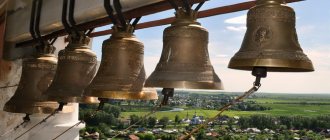| In many cultures of the ancient world, they represented both musical instruments and a cult object (symbol). Many legends say that the ringing of bells summons (forces them to change their habitat) supernatural creatures (for example, dwarfs). Thanks to this, they prevent the devil from kidnapping the human child he desires, have the ability to prevent thunderstorms (as they fetter weather witches), etc. Basic values:
good and evil, death and immortality... | See also: Tools Musical instruments Gong Drum |
Slavs
The bells were borrowed by the Slavs from Europe in the 10th-13th centuries. and fit into the circle of sacred symbols of Slavic culture.
In Slavic legends, spiritual poems, as well as in ancient Russian literature and chronicles, one of the most popular motifs about miraculous bells was self-ringing. In this way, the bell warned people about approaching trouble or expressed their attitude to certain historical events. According to Polish legend, one day an orphan pulled a small bell from the river, took it to the village and hung it in the church. Soon she died, and there was no one to even call in memory of her. Then this bell rang on its own, and rang until it broke.
In legends about sunken bells, the “failure” of a village or church is usually motivated by the threat of an attack by enemies (non-believers), who could desecrate or steal a shrine or relic (church, icon, books, bells); in other cases, "failure" is described as a kind of punishment, the result of God's curse brought down on people for their sins. The village, the church, which has sunk under water or land, is inaccessible to people in normal times, although life there goes on as usual, not consistent with the earthly one only in time coordinates (later - earlier). On one of the festive nights, the border between the worlds is broken and people can observe the life of this city (church), hear the sounds of these villages coming from underground or water, including the ringing of bells. A person who sees a bell in the water or accidentally stumbles upon it tries to get the bell, but at the same time violates some rules of behavior and therefore fails to pull the bell out. According to Czech legend, a woman who was rinsing clothes in the river hooked it on a bell that sank in the river near Staroe Boleslav, and pulled him out. Seeing the bell, she was so surprised that she screamed loudly, causing the bell to break off and go into the depths.
The time when the bell rang was perceived as favorable for the beginning of important affairs and household work, as well as for many rituals and magical acts. Most of them related to the person himself and his health, as well as to the areas of his activity - cattle breeding, beekeeping and gardening. In Skopskaya Kotlina (region of Macedonia), on the first day of the Nativity of Christ, the owner, hearing the bells, ran a scraper three times over each animal standing in the barn, and gave them a little live from a sieve to ensure the offspring and health of the livestock, and the hostess fed in a hoop chickens with grain, so that during the year all the poultry will be with the house and not wander away. In the north of Slovenia, during the ringing of bells on Holy Saturday, the housewife lightly beat the cows with a birch rod so that they would give birth to calves and have a lot of milk, and also fed the cattle with roots, herbs and flowers collected on Holy Thursday to protect domestic animals from diseases.
Easter bells were especially popular among holiday bells. On Easter, everyone could climb the bell tower and ring the bell. During the entire Easter week, Russian girls gathered in the bell tower, sang songs there, danced, rang bells, children played with Easter eggs, etc. In Ukraine and eastern Poland, it was believed that Easter ringing had a positive effect on the growth of buckwheat , so the guys tried to be the first to reach the bell tower on Easter, being confident that then their family would have the largest buckwheat harvest.
The silence of the bell marked the “demonic” time. In Poland, there is a widely known belief that a snake or a toad, which has not heard the ringing of a bell or the sounds of human speech for seven years, turns into a “smock” - a dragon with seven heads, legs, two tails and wings. Avoiding the ringing of bells was a condition for performing magical rituals that implied the intervention of evil spirits. The Slovenes of Styria believed that if you boil a live cat in a pit located in a place where there is no sunlight and where the ringing of bells does not reach, you can get a bone that has the ability to make a person invisible.
The silence of the bell also marked the time when the souls of the dead were present on earth, and their place of residence was a church or bell tower empty at night[2]. The Serbs of Dubrovnik told about a man who heard a bell ringing at night: he went to church supposedly for matins, but discovered that everything in the church was not as usual: the priest and the parishioners had faces without a nose, and the candle that was given to him , the next morning it turned out to be the bone of a dead man.
More than other areas of life, the area of death was associated with the ringing of bells. As soon as a person died, his relatives went to the church to pay for the funeral bell for the deceased. Sometimes the relatives themselves would ring the bell. A dead woman was usually struck twice, and the death of a man was announced with three blows. If the deceased was rich, then they could call him for an hour. There were different types of wire ringing. Among the Dalmatians on the island of Brac, the ringing of a large bell announced the death of a man, and the small one - the death of a woman.
Bell ringing was widely used as an apotropaia. The practice of turning away hail clouds with the help of ringing bells became widespread among the southern and western Slavs. The Bulgarians of Banat, driving away the hail clouds, rang the bell. However, not all bells were equally suitable for these purposes. In the Slovenian region of Lower Krajina, bell ringers from several neighboring villages competed with each other to see which of them would be the first to ring their bell on Trinity Sunday. It was believed that the bell that rang first would have greater power in driving away clouds. The duty of ringing at the sight of an approaching cloud was usually assigned to the bell-ringer. According to the stories of border Serbs, one day local residents beat their bell-ringer because he refused to ring during a hailstorm, which caused all their crops to be destroyed. The bell ringer had to carry out this service for most of the year - from early spring to late autumn, while the threat of hail or rain was relevant.
Bell ringing was considered an effective remedy against many diseases. The Russians were in the habit of “leading the bells” (that is, placing the klikush under the bell in the bell tower), since the demons that overcome them supposedly cannot stand the ringing of bells; The same was done with children and adults in case of fright, fever and other diseases. The Croats of Samobor, in order to rid the baby of the tormenting night spirit, fumigated diapers with smoke from the bell's lubricant. The rope from the bell was also used in folk medicine: Serbian women grabbed it during the ringing to get rid of pain in their hands, Bulgarians gave sick children water to drink, in which a piece of such a rope was placed.
SERVICES FROM EASTER TO PENTECOST
From Easter to Antipascha
VESPERS: strikes on the festive Blagovest (15 min.), pealing at full blast (10 min.)
MORNING: strikes on the festive Blagovest (15 min.), ringing at the top of the voice (7 min.)
LITURGY: ringing as at Easter (except for the ringing for the Gospel).
Procession of the cross: ringing at full speed from the beginning to the end of the procession.
Throughout the week (until the Sunday all-night vigil) the ringing will be from the end of the liturgy to the beginning of the ringing for Vespers.
From Antipascha to Ascension*
VESPERS: strikes on the Sunday Blagovest (15 min.), trezvon at full blast (7 min., without the holiday Blagovest).
Compline: 12 strokes on Sunday Blagovest.
MIDNIGHT OFFICE: 12 strokes on Sunday Blagovest.
MATTNS: strikes on Sunday Blagovest (15 min.), ringing at full blast (7 min., without the holiday Blagovest).
LITURGY: strikes on the Sunday Blagovest (15 min.), trezvon at full speed (7 min., without the festive Blagovest).
Eucharistic canon: blows on the Sunday Blagovest from “It is worthy and righteous to eat...” to “It is worthy to eat...”.
From Antipascha to Ascension, after each Sunday liturgy, a full trezvon is performed. The ringing for the Sunday All-Night Vigil and Liturgy is performed with the festive Annunciation.
FOR THE CELEBRATION OF EASTER: ringing as in the BRIGHT OF CHRIST
RESURRECTION (except for the bell ringing for the Gospel reading).
From Ascension to Pentecost
The ringing occurs as on ordinary days.
China
In East Asia, bells were rung using a special beat, mounted on a special stand and swung in a horizontal plane.
There are many legends associated with bells, for example, about bells that can fly through the air to a certain place[3], or about bells predicting happiness or misfortune with the height of their sound.
Pictures with images of bells serve as a wish for advancement in the official hierarchy (through passing exams) < the word “bell” (zhun) means the same as “overcome tests (exams).”
Respect, adoration, submission of faithful servants, honored warriors. The ritual bell symbolizes harmony between man and Heaven.
Takes away the evil eye and protects from the evil spirit.
POLYELAY SERVICE
VESPERS: 50 beats on the polyeleos Blagovest. Trezvon (5-7 minutes excluding Sundays and holidays).
Compline: 12 beats on the polyeleos Blagovest.
MIDNIGHT OFFICE: 12 blows to the polyeleos Blagovest.
MORNING: By the beginning of 50 blows to the polyeleos Blagovest.
Trezvon (5-7 minutes, excluding holidays and Sundays). To the Gospel Trelling from Stepenne... to the cry of “Peace to all.”
On the Most Honest 7 blows to the polyeleous Blagovest.
LITURGY: To the beginning of 50 strokes of the polyeleos Blagovest.
Trezvon (5-7 minutes excluding Sundays and holidays).
Eucharistic canon: blows to the polyeleous Blagovest from “It is worthy and righteous to eat...” to “It is worthy to eat...”.
Christianity
A bell or bell ringing is an object of Christian cult that has received various ritual and magical functions in folk culture.
In the era of early Christianity, bells (most often made of silver) were also used in the Roman catacombs to collect gifts.
Large bells first began to be used in monasteries and are mentioned from the 6th century; there is information about the casting of very large bells in Europe only from the end of the Middle Ages.
Church bell:
- convenes believers for worship;
- encourages believers, puts evil spirits to flight, calms storms.
The cavity and tongue of the bell are the mouth and tongue of the preacher.
The sanctus bell on the altar announces the coming of Christ during communion.
Attribute:
- Anthony the Great, St. - attached to a crutch or T-shaped staff to ward off demons;
- personified Music (Seven Liberal Arts) - strikes a set of bells with a hammer;
- King David - strikes with a hammer a set of bells on miniatures of medieval psalters;
- Aaron - bells or bells frame the priestly robe;
- Benedict, St. - a bell tied to a rope on which bread is raised for the hermit.
History of bell ringing
Photo: Flickr.com
Since ancient times, objects that could produce a loud sound that could be heard in all parts of the country were used to call people to the temple for prayer. In the beginning it was a wake-up call. But then the art of ringing bells developed, the bells became smaller and larger, emitting sounds of varying strength and height. The bells were cast from different metals and alloys, which were harmoniously combined with each other in resonance.
The purpose of ringing a bell in those days was to unite people for prayer, since it was supposed to be cathedral, universal. People should praise the Lord together in the temple of God.
What type of bell ringing is there?
The game in Russia is different from the game in other countries. Since ancient times, in Rus', bell towers were arranged in such a way that no sound was produced when the bell and tongue were swung. They struck our bells, that is, the bell was motionless, and the tongue struck it, swinging like a pendulum on a string.
Of course, this method gave many more opportunities to express one's feelings in the ringing of a bell; the sound became more subtle, predictable and melodic. In addition, as already mentioned, the many sizes and shapes of bells made it possible to fully comply with the canons and produce not only temple bells, but also melodies.









